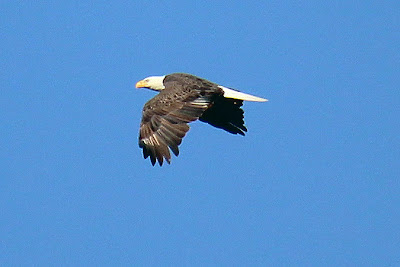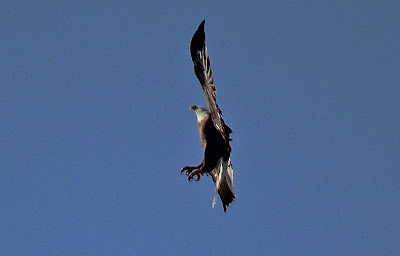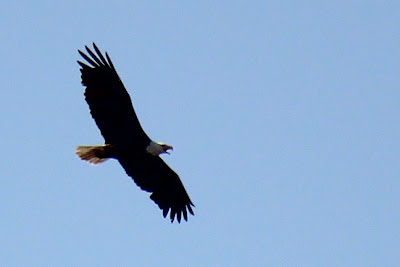John Bunker Sands Wetland Center On The Trinity River
 |
| Adult male Bald Eagle Haliaeetus leucocephalus; initiating a high speed 100+ mph hunting dive into the John Bunker Sands Wetlands |
Want to see some Bald Eagles? Read on. It all began began with the premise of turning a cattle pasture into a wetland. The periodic floods of the Trinity combined with pancake flat landscape created brief wetland environments that transformed the pasture into a bird magnet overnight. Twenty years ago, a man named John Bunker Sands had a vision of turning that cattle pasture into one of the largest created wetlands in the United States.
Now it’s a place where nature and state-of-the-art science collide on the Trinity River. Where the only crop grown is water. The byproduct is a unique habitat for wildlife rarely seen in North Texas. Home to eagles, bobcats, otters and hawks the spectacular vistas of the public-private partnership are a real gift to North Texans.
 |
| John Bunker Sands Wetlands at sunset under a rising full moon, March 2013 |
The late John Bunker Sands was the son of Loyd Bowmer Sands and Caroline Rose Hunt. Coming from a family of Texas outdoors enthusiasts, John Bunker Sands enjoyed spending time on the five ranches in his family’s holdings. His original idea was to take waste water from surrounding municipalities and funnel it through a wetland biofilter before it entered the river. At the time it seemed pretty far fetched but quickly gained traction. The North Texas Municipal Water District jumped onboard and the resulting public/private partnership formed the John Bunker Sands Wetlands we see today.
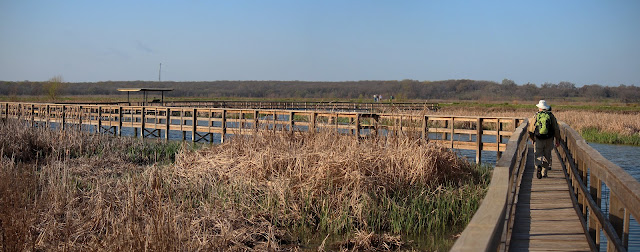 |
| Catwalk above the Wetland Cells |
 |
| JBS Bald Eagle |
Directions: US 175 south to FM 1389, head south two miles to Martin Lane, entrance is on left off 1389
John Bunker Sands Website: www.wetlandcenter.com
East Fork Raw Water Project: http://www.ntmwd.com/re-use_info.html
Open first and third saturdays of the month, $5 admission 9am-4pm, open other times by appointment. A visitor center with displays, restrooms, classrooms and meeting room sits at the headquarters with a commanding hilltop view of the wetlands. Rocking chairs are free.
Bald Eagle nest is on far south end of property along a utility right of way. Directions to the nest can be found further down in this post.
Known mostly by Dallasites as the part of DFW where people congregate to buy fireworks for the 4th it makes for an interesting drive from Dallas. One can head back to Big D as an alternate route using Malloy Bridge or other old country roads that head back towards Wilmer and Ferris. The landscape is full of nameless odd little communities down that way. Peppered with front yards featuring long forgotten front yard plastic nativity shepherds, wind flapping textiles and old half taken apart motorcycles. Worth a look.
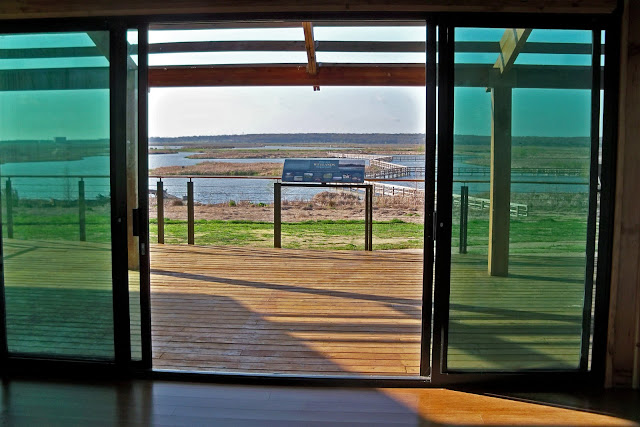 |
| Looking out over the wetlands from the visitor center |
How it works
The wetland processes 40-90 million gallons of water per day. The water is a mix of treated wastewater and water from the Trinity River discharged below Lake Ray Hubbard. Pumped in by a trio of 300 horsepower pumps from the river to the head of the wetlands. From there it’s all nature and gravity at work inside the wetlands.
As seen above(click to enlarge) a series of sedimentation ponds north of US 175 settle out the solids and silt to a large degree over the process of a day or so. From there the water travels south only by gravity, where the natural processes, sun, wind and over 20 million aquatic plants filter out phosphorous, nitrogen and ammonia from the water.
The whole process, start to finish takes 7-10 days. At the end of that time period, the water is so clean that it can be pumped back up into Lake Lavon for human consumption. Which is exactly what happens. Three, 3,000 horsepower pumps take the water out of the wetlands and pump the water up the Trinity in 43 miles of pipeline back to Lake Lavon where it can be reused for municipal water use. The amount of water cleaned in the Wetlands everyday is equal to the amount of water pumped out of Lake Lavon by the North Texas Municipal Water District.
 |
| Hawk hunting the wetland cells |
Walking the property is easy. A boardwalk leads from the Wetland Center across a couple of the cells. From there one can walk the levee top roads that separate the individual ponds. Cover and concealment is not readily available for watching wildlife here. The distances to see wildlife are at somewhat great distance and binoculars or a long spotting scope are recommended. The Wetland Center has loaner pairs of binoculars available.
 |
| Master Naturalist Bill Holston left, Scott Hudson right, with wildlife viewing blind in background |
Dotted among the levees are wildlife viewing blinds which would afford more stealthy viewing of wildlife if one chooses. There were so many birds around that day that sitting in a static location was not tempting in the least.
The Wildlife
 |
| Male Bald Eagle at John Bunker Sands |
It would be interesting enough to see the water filtration process in action. There is much more. Interesting birds by the thousands call this place home. Most are of a migratory persuasion and spend a day or a week here before heading yonder to points unknown. Canada in the spring. Mexico in the fall. During the summers birds of the southern hemisphere come here during their winter. On the edge of the Flyway, the wetlands attract the occasional flock of geese not seen further west.
This particular trip was in March 2013 when many of the birds of the polar north, land of the Midnight Sun were still in Texas.
 |
| Northern Shoveler Anas clypeata |
Birds like the Northern Shoveler seen above. Their summer range extends from Alaska through western and central Canada south to the mountain regions of the Rockies. Nicknamed the spoonbill duck, the Northern Shoveler has the largest bill of any duck in North America. The bill is this bird’s most prominent feature, and is longer than its head.
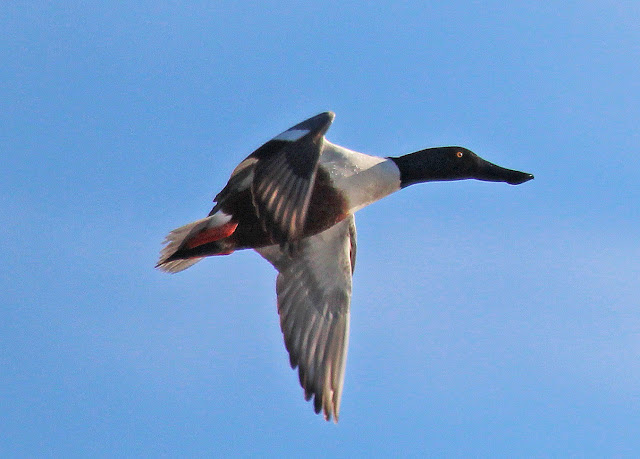 |
| Male Northern Shoveler |
Pelicans
 |
| American White Pelican Pelecanus erythrorhynchos |
One of America’s largest birds the American White Pelican has a wingspan of nine feet and is easy to identify by a unique black band running down the wings. Many think these are birds of the sea but in actuality are inland birds. Banded individuals in this flock suggest they summer in the far reaches of Idaho, Wyoming and Montana in the Yellowstone, Madison, Snake and Columbia drainages.
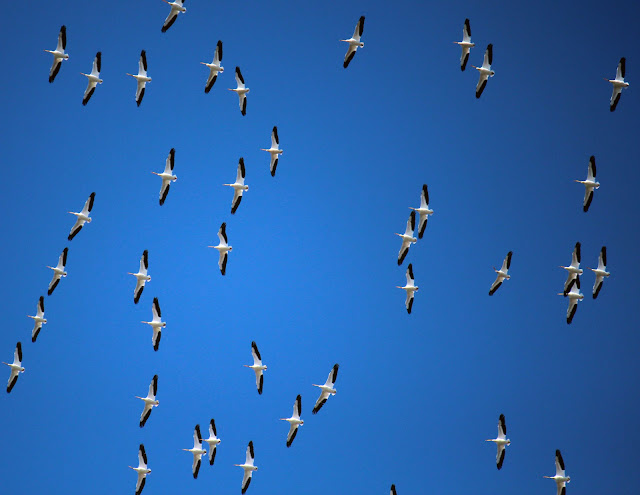 |
| Flight of pelicans over the John Bunker Sands |
The pelicans here make regular commutes between John Bunker Sands, the McCommas Bluff Swale Lake Ray Hubbard and White Rock Lake. Able to glide vast distances using thermals and wind the near effortless rise of a flock spiraling upward is a sight to see.
 |
| Pelicans fishing at John Bunker Sands |
Many of the birds pack into the ten foot tall grasses and marshes that divide the wetland cells. Here the familiar American Coot (Fulica americana) and Blue-winged Teal (Anas discors) not similar in appearance but both dabblers feed together in mixed company.
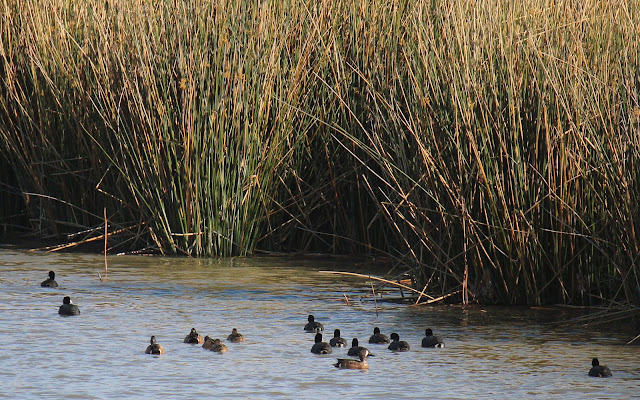 |
| American Coots and Blue-Winged Teal |
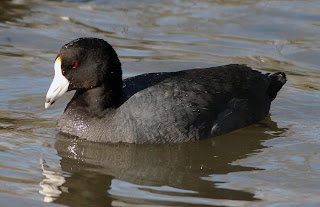 |
| American Coot Fulica americana |
Coots which resemble ovalized waterborne chickens tend to make bee lines for marsh cover when approached rather than the ducks which always take flight.
Coots communicate distress to each other by exposing their under tail coverts or displaying a swollen shield when alarmed by potential dangers such as hawks, airplanes, or predatory mammals. Similarly, aggressive displays are not restricted to avian intruders.
 |
| Blue-winged Teal Anas discors taking flight |
 |
| Great Egret Ardea alba |
Many other common wetland birds reside here from egrets, cormorants, herons to red winged blackbirds.
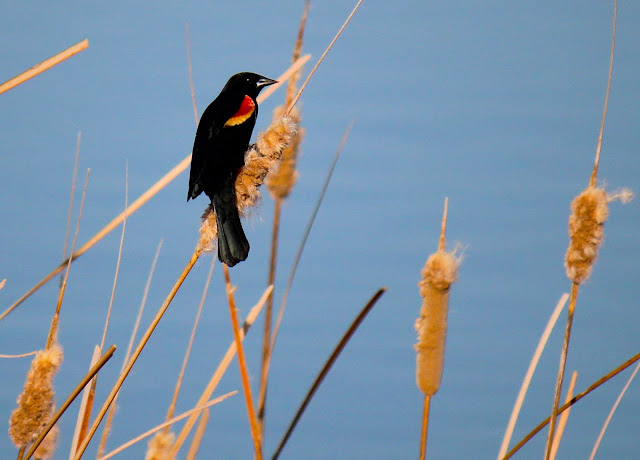 |
| Red-winged Blackbird Agelaius phoeniceus |
Combined as a whole, they create a unique footprint into what was once a cattle pasture. I imagine most people turn around about this point of the wetlands, filled with the typical wetland sights and sounds one would be expected to see. If you head further though, down on to the south end of the property things start to get interesting………..
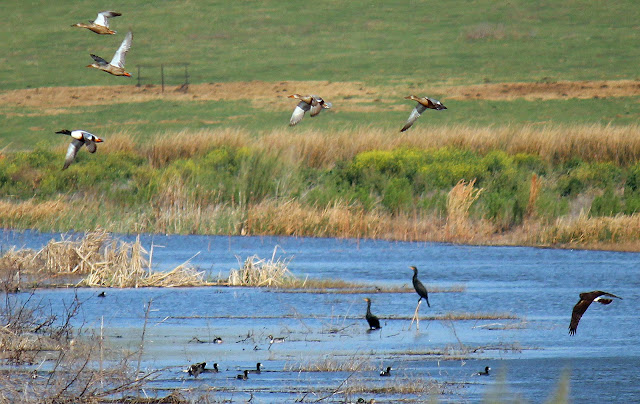 |
| Northern Harrier (right foreground) jumping a pond of ducks, coots, cormorants |
The available food supply in the cells serves as a grocery store for raptors. Hawks, Harriers and two species of Eagles work the ponds here with great precision. Unrestricted by trees and obstruction they start lengthy hunts at high altitude and then dive out of the sun at their quarry below. In the case of the Northern Harrier above, his true prey was something with four legs down in the marsh grass not the ducks that took flight at the sight.
Below, a White Faced Ibis flies over the wetlands, a rare sight for early spring the birds are more numerous in the summer months. Habitat loss in Texas has dwindled the numbers of this ibis species and is now afforded protection as a Threatened Species.
 |
| White Faced Ibis Plegadis chihi listed as a Threatened Species, flies over the John Bunker Sands Wetlands |
 |
| Flushed Northern Shovelers landing in a pond of lotus |
With the hundreds of different plant species thriving in the various cells each pond has a different look. I cannot recall an area lake or impoundment with lotus.
Eagles of John Bunker Sands
 |
| Male Bald Eagle over John Bunker Sands |
Cutting your eyes to the right from the rocking chairs on the back porch of the visitor center one can see it. A half ton pile of branches the size of a dinner table one hundred feet in the air. Sitting at the far southern end of the property beyond a set of fences and a cattle pasture. The nest of the Bald Eagles. More of a crucible of sorts used to forge a new generation of Bald Eagles that will one day repopulate North Texas.
There is something all together unique about seeing a Texas Bald Eagle. The aesthetics of the birds in flight, speed and resolute prowess tap into the human spirit that few other species can duplicate. If you have never seen wild Bald Eagles, this is your chance.
Bald Eagles are not hard to find they are just spread few and far between in North Texas. Knowing where to look and eyes peeled to the sky one can find them without much trouble. With wingspans of 7 feet they standout on a sky landscape like no other bird. Below is a map with aggregated sightings of Bald Eagles in and around Dallas County. The blue hot spots note 3 to 5 sightings and the orange hot spots note a dozen or more. Eagles frequent with regularity the tail races of Lewisville Lake and Lake Tawakoni during the winter months. The annotated map is from data compiled via http://ebird.org which is a great resource for sightings based on specific birds based on date and geographic area.
 |
| Combined Bald Eagle Sightings in the Dallas County area Fall 2012-Spring 2013 |
The Bald Eagle sightings around the Wetland Cells and Audubon Center are a group of three eagles and most often a juvenile bald eagle with brown head and tail is seen the most. Moving between the Wetland Cells north of Loop 12 and the McCommas Bluff Swale to the south, sightings are frequent.
The Sand Branch Bald Eagles feed near the Wastewater Treatment Plant off Beltline Road near the impromptu community of Sand Branch. High fences and a somewhat chilled response of area residents dictates that a search for Bald Eagles in this area is best done with an organized group.
The easiest, most reliable and with near 100% certainty of sighting a Bald Eagle is at John Bunker Sands. A pair of binoculars and some eyeballs are all that is required. Asking around, checking and doing some homework, the only other Bald Eagle nest known in the Greater Dallas area is one on private land near Ennis. That nest is not accessible to the public and from what I understand is hard to see.
 |
Nest location:
Google Maps link to site-
John Bunker Sands Eagle Nest Site
The nest is located at the far southern end of the John Bunker Sands property in a high power transmission tower. A series of fences and cattle pasture off-limits to the public keeps a healthy buffer between guests and the tower. 500 feet or so. That’s about as close as one can get.
There are two ways to see the nest:
1. Visit the John Bunker Sands Wetland Center on the first or third Saturday of the month. Ask about the nest site and a staff member will tell you where to go. The southern perimeter fence is electrified in nature, most likely to keep cows from straying into the ponds.
2. Head south down 1389 and pull off the side of the road about 1/2 mile south of Martin Lane. You should be able to see the nest and female with babies especially late in the day as the sun will be at your back. There is a subdivision with new homes a little further to the south that gets fairly close to the tower but trees obscure the nest and 2/3 of the tower. If the male is on top of the tower it can afford a 400 foot vantage point.
I have done both. The nice hike on the John Bunker Sands Wetlands is very rewarding and a must do. If time is a limiting factor then the second option is a distant second. Usually I would not post the location of a nest site like this until long after the offspring have left the nest. In this case, the private property boundaries, fencing and location offer great restricted viewing without disrupting the nest site.
 |
| Female on nest with baby eagles as viewed from the John Bunker Sands Wetland Center property line |
 |
| Crested Caracara |
The nest is very easy to see and the female is more than likely always at her nest guarding her newborns and tending to domestic duties around the site. The male is often seen hunting or perched on one of the nearby transmission towers or tall trees in the area.
The abundance of other raptors in the area can make it hard at first glance to sort out which large bird is the Bald Eagle. The bird at right, a Crested Caracara was seen not 50 yards from the Bald Eagle nest site flying around. Known as the Mexican Eagle and featured on the flag of Mexico at a distance bears a striking resemblance to that of the Bald Eagle.
The Bald Eagle gained unofficial recognition as the American National bird in 1782 on the US seal. Since then it has become a defacto symbol of the United States.
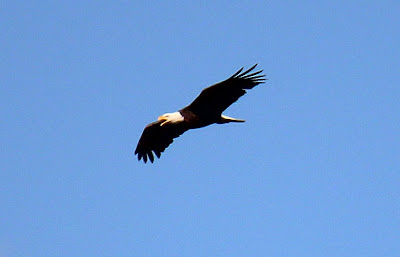 |
| Male Bald Eagle over the wetlands screaming a cry |
The John Bunker Sands eagles have been nesting in this area off and on for the last several years. Previous nest sites included a large tree closer to US 175 and a different transmission tower in the same line as the current nest. These are Southern Bald Eagles and vary slightly from the more numerous Northern Bald Eagles.
As a general rule, Northern Bald Eagles will migrate down south for the winter months following their prey species as they go. Northern Bald Eagles rarely nest below the 40th parallel and as a result just visit here in Texas rather than mate. The Southern Bald Eagles live and breed below the 40th parallel with concentrations in the Gulf States, particularly close to open bodies of water.
 |
| Male landing on transmission tower |
The windy days of early spring made for difficult video capture. Even with image stabilization and a sturdy tripod the winds over 30mph proved too much. Below is what one can see from a few different vantage points:
The high winds allowed for ground speeds of the male Bald Eagle to exceed over 100 mph. Much closer to 150 mph by my calculations.
Hunting for lunch
Naturally, the most exciting part of seeing a Bald Eagle is watching them hunt for food. Most of their diet consists of fish, ducks and small animals in that order. The abundance of all three in the area provide a solid foundation for success of a nest.
It was a rare treat to watch the male Bald Eagle begin a series of high arching dives and wheeling turns directly overhead. Rare is a day when I gasp in awe at a bird doing something. Rarer still when a group of what I would consider seasoned outdoorsmen all gasp in collective agreement. That happened.
This was the moment that it happened. A 125-150mph dive right at us with a monster braking pull up right above our heads. I have never seen any bird pull off something like that. You can see the bird’s face straining through the pull using the tailwind behind it and speed to regain altitude.
For one such series of dives, I swung around and took a photo of Master Naturalist Bill Holston watching that Bald Eagle hunt for all it was worth. The look on his face is priceless.
And not even five minutes later, lunch is served……..
Photographed at some distance, the male is seen carrying a large catfish back to the nest. This catfish was caught by the eagle closer to US 175 and then hauled back directly to the nest. He dropped it off without taking any for himself.
This is the female feeding her young inside the nest after the male has dropped off the sushi.
After a few minutes of perching on a nearby tower, cleaning his bill, talons and adjusting flight feathers he take fight again. Screaming his song of victory. Frankly, it was flying around so much directly overhead that I put the camera down after awhile and just kicked back in the grass, watching it work the cells up and down at 100 mph. This is what qualifies as a high quality experience on par with what one would see on African safari or Pacific whale watching. Just as rare, unique and satisfying.

